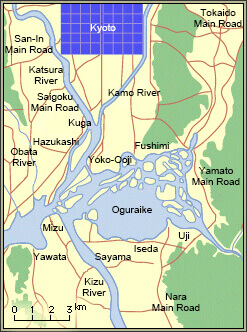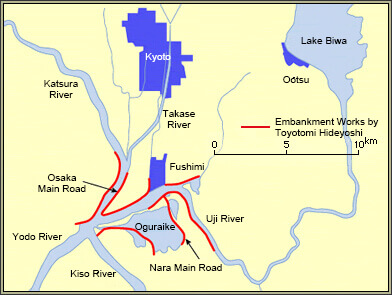

The three major cities of Japan are Tokyo, Nagoya and Osaka, and all three were built during the early modern period. Tokyo was founded and flourished by Tokugawa Ieyasu (1543-1616), Nagoya by Tokugawa Iemitsu, the third shogun of the Tokugawa dynasty (1604-1651), and Osaka by Toyotomi Hideyoshi (1537-1598) together with his construction of Osaka Castle.
When the new city of Edo (now Tokyo) was established Tokugawa Ieyasu launched a major project transfering Tone River to the east. Tone River, which originally flowed into Edo, was rerouted to Watarase River and other rivers so that it would flow toward the vicinity of Kasumigaura (in Ibaraki Prefecture).
Nagoya is said to have been built by relocating the entire city of Kiyosu. In this process, an extremely long dike called Okakoi-zutsumi (Okakoi Dike) was constructed along Kiso River, which encircles the entire area of current Nagoya City.
Both large-scale projects were painstaking drastic measures. It is absurd to think that Tokugawa Ieyasu and the Owari (Nagoya) branch of the Tokugawa family personally envisioned modern metropolises, but whoever might design them, it was an undeniable astounding fact that their projects established the urban structures that are still in use and viable today.
On the other hand, how was Osaka built by Toyotomi Hideyoshi?
Although it is not well-known to the public, we might say that it was Toyotomi Hideyoshi who was the true genius on civil engineering in Japan. Beginning with Sunomata Castle, which is said to have been built overnight, and his sieging techniques around Takamatsu Castle, with which he rerouted a nearby river in order to flood his enemies out, there was no other warlord who made such effective use of topography and civil engineering.
So why did this excellent strategist of civil engineering choose to build Osaka Castle in Naniwa (now Osaka) which at that time was almost nothing more than a wilderness of marshland? Leaving that discussion to historians, we need to be aware that for some reason, Toyotomi Hideyoshi in his later years moved to Fushimi (in Kyoto) and built Momoyama Castle, arranging the residences of all of his daimyo (feudal lords) nearby.
Today Fushimi is seen as just one of Kyoto’s many towns:
however, at least until the Edo era, this has continually been a place of great strategic importance within the Yodo River basin.

Map 1
This warlord of sengoku (warring states period) with his remarkable sense of civil engineering must have considered that the key to the prosperity of Osaka was this area.
Toyotomi Hideyoshi partially diverted Uji River, which originally flowed into Oguraike, to the city of Fushimi where he developed river ports. Further, he constructed dikes along Kizu River and Katsura River in order to fix the flow of the rivers to the west side, while building roads on the top of the dikes and using them as the Osaka and Yamato Main Roads (see Map 2).

Map 2
Reprinted from Oguraike Kantakushi (History of Land Reclamation in Oguraike)
【 (Oguraike Land Improvement District) 】
Shortly after, Toyotomi Hideyoshi became heavily sick and Fushimi Castle was abandoned. Still, his works were extremely significant. It is no exaggeration to say that the early modern period along Yodo River began through his undertakings. Regulating rivers with dikes reduced flood damage and facilitated the discharge of debris. Thanks to this, the delta at the mouth of Yodo River grew rapidly and expanded the area of Osaka city.
After Oguraike was reduced and stabilized, farmlands outskirt of this
lake increased.
Major main roads connecting Kyoto, Osaka, and Nara were developed.
Above all, thanks to the construction of the river ports in Fushimi, excavation of the Takase River carried out by Suminokura Ryoui in the early 17th century was successfully completed. For the first time in history an artery of transportation between Kyoto and Osaka was achieved. Consequently, this came up with a large-scale economic zone.
The economic effects brought about by the improvement of transportation networks are immeasurable.
Villagers in the region shifted from self-support agriculture to business agriculture in consideration of city markets. Farmers shifted drastically to cultivation of commercial crops such as wheat, cotton, rapeseed, and indigo, other than vegetables.
Throughout the early modern period, agricultural production in the Kyoto-Osaka-Kobe area has been far superior to other regions.
As for cotton farming, in particular, it brought the outstanding outcome: that is developing Osaka into a great zone of cotton textile industry.
The process, by which agriculture nurtures cities and reversibly cities nurture agriculture, can be seen vividly in the early modern history of this area.
Thus, rivers from Lake Biwa was transformed by Toyotomi Hideyoshi into urban rivers.
